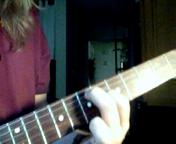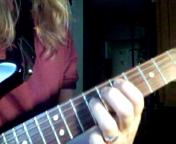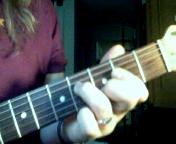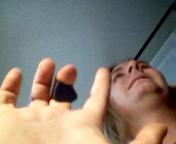Scroll through the lesson and click on notation/video/audio links to load the interactive players.
Please subscribe to get full access to all lessons for only $7.95/month PLUS 1 week free trial.

Riff Interactive lessons are
LESS expensive and
MORE interactive than alternatives!
More Info
|
|
| Lesson Subject:
Eddie Van Halen Style |
| What you learn:
Part I |
| Storm:
Storm Stenvold |
Lesson Sample
Storm: In this lesson
we're starting a series on the incomparable Eddie Van
Halen. Here are a couple jam tracks
for this first lesson.
Van Halen Lesson
Jam Track
E Vamp Jam Track
Storm: Eddie came to prominence with his
self-monikered group, Van Halen in the late 70's. His first album floored
guitarists with an incredible combination of technique, tone and riffs and
is regarded as a hard rock classic. His unaccompanied solo 'Eruption' sent every
rock guitarist back to the 'woodshed' to practice their picking, legato and a
new, must-know technique - 'two-handed tapping'. Van Halen had platinum albums through
the '80's and 90's as Eddie continued to expand the sound of hard rock
with classic songs and his innovative technique. Eddie had a few
different guitars. This famous mongrel guitar was
home-built, given the moniker 'Frankenstein'. Today he uses a Peavey
Wolfgang.
randy_wylde: The
paint job on his guitar originally started when he put masking tape all over one
of his guitars, then he got them painted like
that.
Storm: Eddie later endorsed Kramer
guitars. This is another famous axe, his main
road guitar through most of the 1980's. A few thing's would be common to
all Eddie's guitars. First is a bridge, humbucking pickup for a bright,
overdriven sound. And no tone, just a volume knob.
MikeCC:
I assume the tone was on 10? Automatically?
Storm: Yep. Also important is to have a vibrato
bridge, preferable one with a locking nut because by the end of the series we
will put the whammy bar through some serious paces. Eddie set his flush
with the body, no upward travel. Also the humbuckers are screwed directly to the
wood on his early guitars. I don't expect anyone to go that
length.
Aaron: Any suggestions on a good Van Halen amp
setting?
randy_wylde: Bass 50% mid 50% and high
100%
Storm: Van Halen used a 67 or 68 Marshall for
much of his career, now using Peavey 5150 heads. Go for lots of presence. Let's get to some rhythm guitar parts.
They will be in the key of E. Try these to the E vamp Jam
Track.
Van Halen Rhythm 1
Van Halen Rhythm 1
Storm:
We'll use the jam track at the beginning of the lesson
later. It has more changes for soloing over. A
- E - A - C#, that first track is by the
way.
MikeCC: What scale is that?
Storm: E Mixolydian scale. It has all the notes
as E Major but with a D natural note instead of D#. Rocking' but still up and
happy. Very common to blues. Also called the dominant scale. Like E7. We add the
b3rd on the E string 3rd fret for a blues note. It just straight overdrive. Eddie would
use a few effects, too. His best effects are his hands
though. Notice a little vibrato on that
double-stop in the middle of the phrase. That kind of
thing. Some effects he uses are flanger, echo,
delay, and chorus. Sometimes subtle, sometimes extreme. We will get into
Eddie's effect use and his 'neat noises.' Here's a riff
variation.
Van Halen
Rhythm 2
Van Halen Rhythm 2 Audio
MikeCC: He uses
volume swells with fast delay!!! that
rocks!
Storm: Yep. The 'Cathedral' sounds. Starting
strengthening your left hand for that
one. And another riff
variation. Before I send it, I'll mention and show
the two note, or double-stop, riffs. These are a great way to imply major or
minor chord with distortion. Eddie uses them allot.
Major
3rd

minor 3rd

Storm: That last part of the riff could return
to E but makes a nice walkup to the A chord in the opening jam
track. Here another
riff.
Van Halen Rhythm 3
Van Halen Rhythm 3 Audio
Storm: This riff
uses more two note chord voicings. The traditional power chord, in open position
E and at the seventh position.
E5 Chord - 1 finger

E5 Chord - 2 finger

Storm: The 2 finger voicing is also moved down to
5th position to work for a D chord. D5 it is called. Also, another way to imply
a major chord with two notes. This A/C#, or an A chord with a C# in the bass.
Aaron: Are we
going to go over soloing techniques
later?
Storm: A lot in the next lessons. I will have time
for a couple licks in this lesson. We'll probably use this same jam track next time
too.
Van Halen Rhythm 4
Van Halen
Rhythm 4 Audio
Storm: And a riff for the A change and then a
tapping lick, Eddie Van Halen's famous technique.
Storm:
This one used two favorite voicings of
Ed's.
A Major
Chord

D
Major Chord over A bass note

Storm: After strumming the chord, you tap the
string 12 frets above. This is called a tap harmonic. If the notes aren't at the same fret you
must outline the chord shape 12 frets
higher.
MikeCC:
Like in Spanish Fly!?
Storm: Exactly. I have a video at the
end.
Storm:
And here is a favorite tapping figure of Eddie's. The same shape then moving the
left hand down chromatically.
Van Halen Tapping Riffs Audio
Storm: Alright, we will do some more solos over
this track next time. Lots of tapping, left hand legato, speed picking, all
that. And we will do some fun sound effect stuff that will annoy the
neighbors.
Van
Halen Tapping Riffs
Storm: Tap at the 17th fret. Eddie uses his
index finger, hiding the pick in his middle finger most of the
time.
Pick - Slight
of Hand

Storm: Let's have fun, first and foremost. But
practice gets you better, and it is always fun to see improvement.
Storm:
I'll hope to have you all back here next time. Got to go. Thanks and keep
picking!
|
<< load notation from left
|
|
<< load audio from left
|
<< load audio from left
|